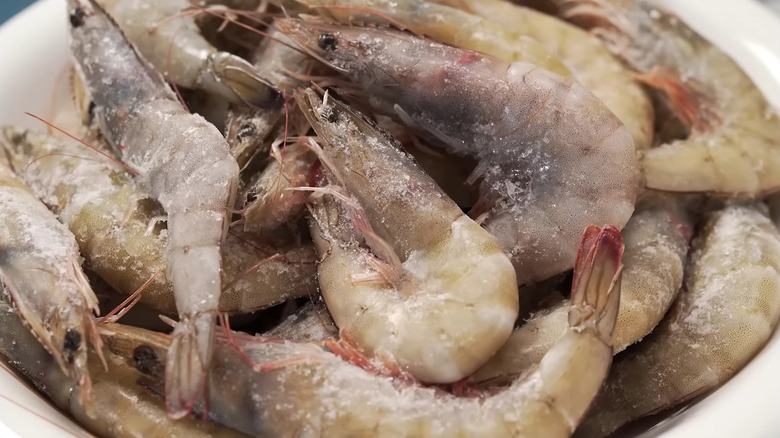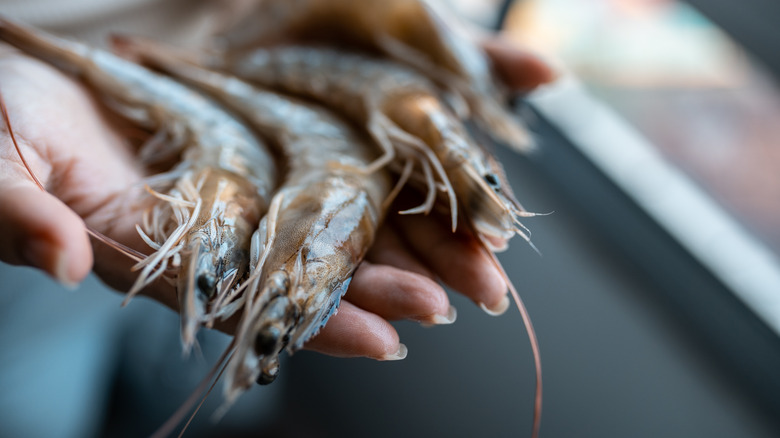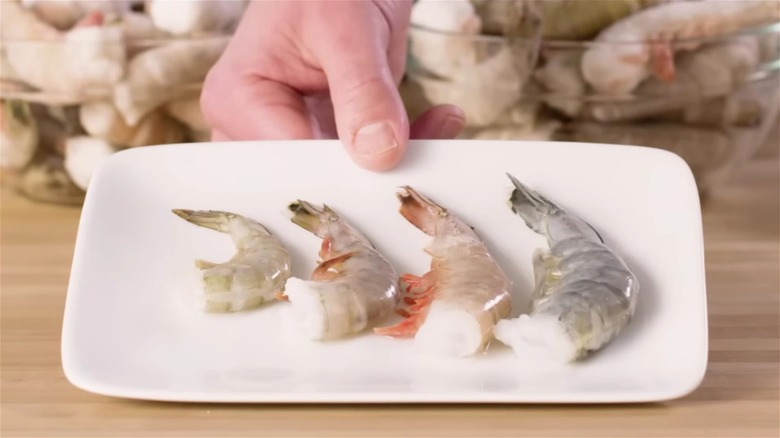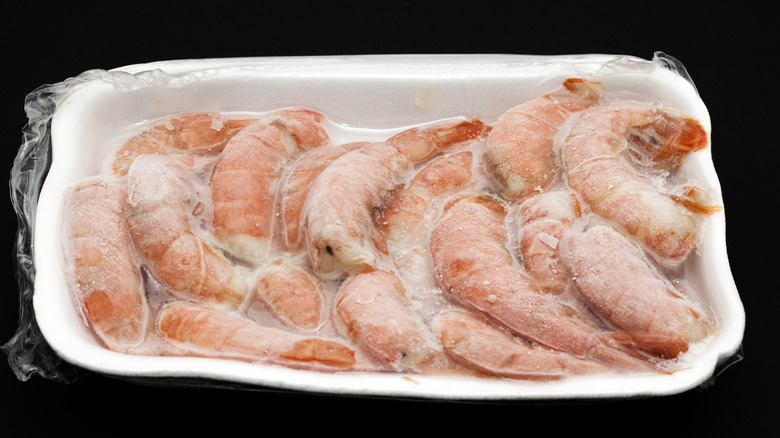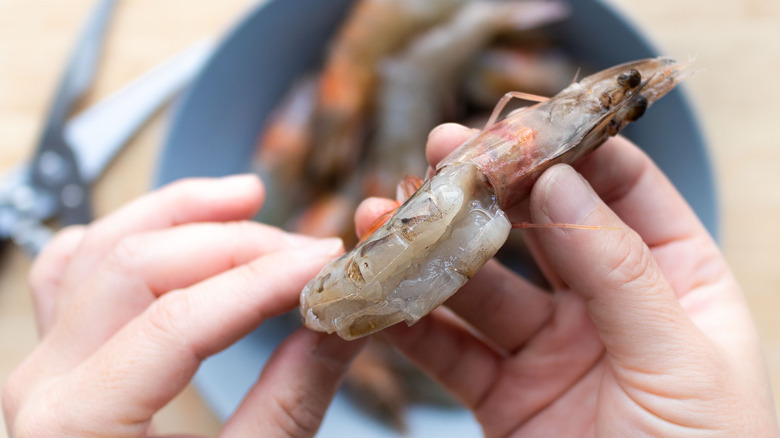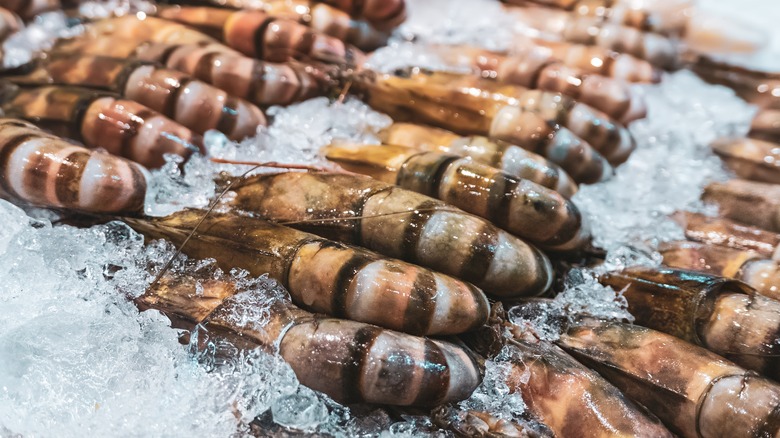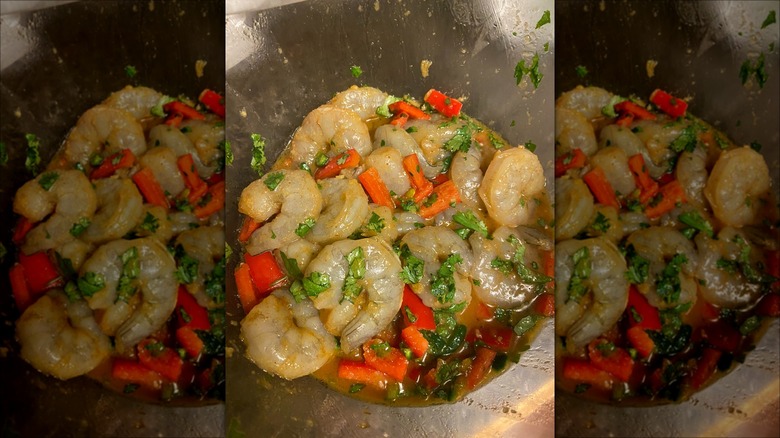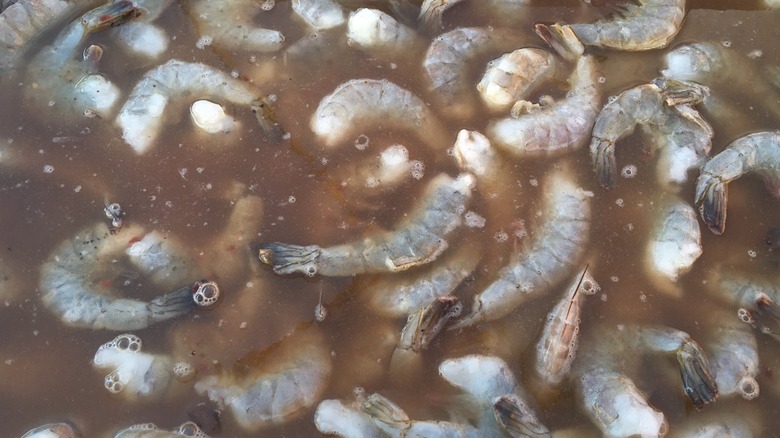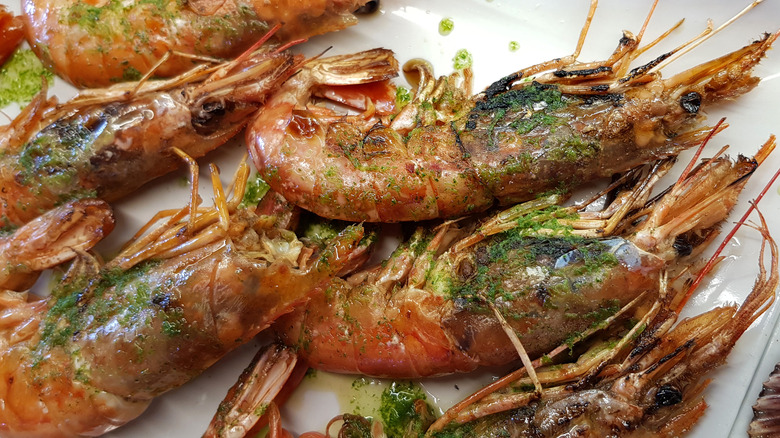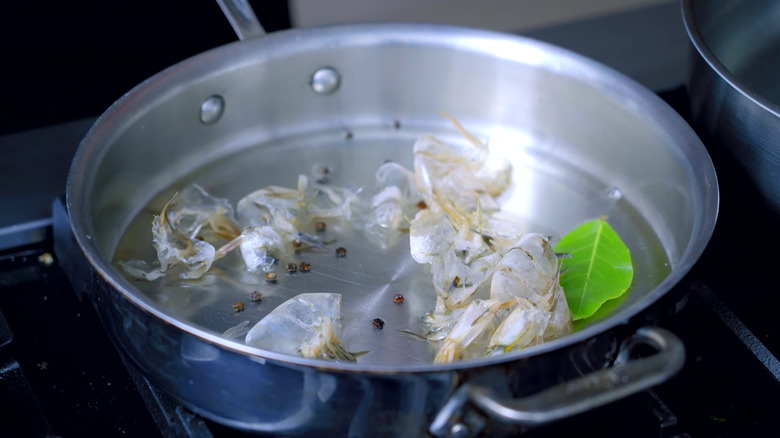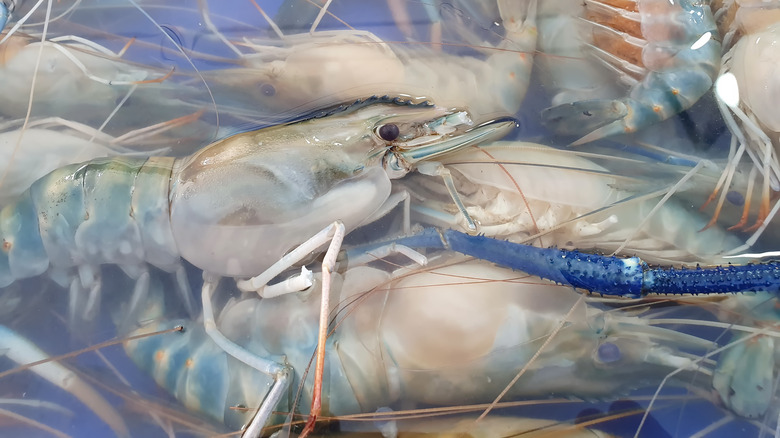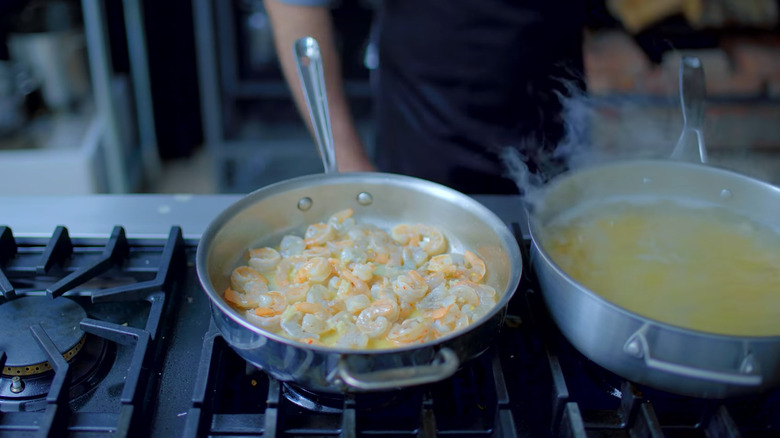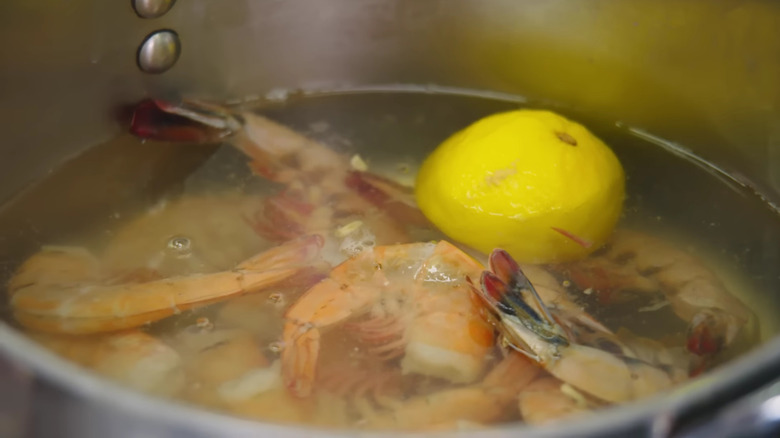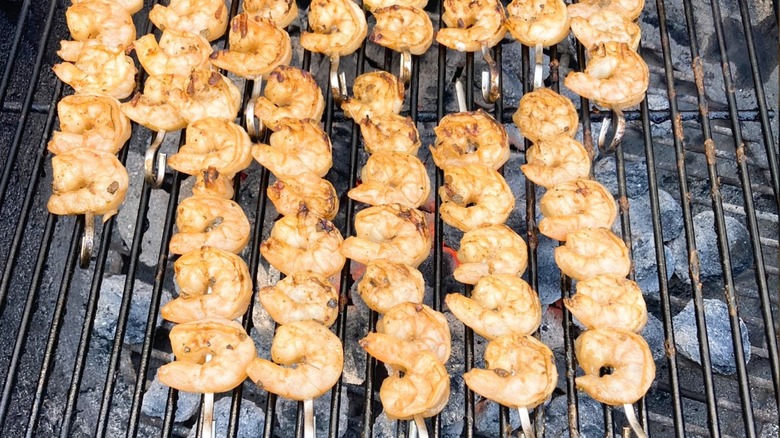All You Ever Wanted To Know About Cooking Shrimp
Shrimp has been a favorite seafood of Americans for many years and demand for it is still growing. A 2021 survey conducted by the National Fisheries Institute found that American shrimp consumption per capita stood at 5.9 pounds for the year, increasing by 0.9 pounds from the year before.
Despite this crustacean's ubiquity, many Americans still lack knowledge when it comes to cooking them. This is not entirely their fault. In the kitchen, shrimp are extremely versatile and can be found in a wide range of cuisines. This means they can be prepared and cooked in a myriad of ways, making them a tricky ingredient to fully master. What's more, the huge demand for shrimp sees many different varieties imported to the U.S. every year. This further complicates shrimp cooking because each of these has unique characteristics.
In an effort to simplify matters, we've collected a range of information about cooking shrimp. This spans from the best cooking methods for different types of shrimp to the risks associated with marinating them. In short, it's all you ever wanted to know about cooking shrimp.
Individually quick frozen shrimp are best
The first thing to know about shrimp is that they are rarely sold fresh. Most shrimp sold in the United States are frozen immediately after being caught, while still out at sea. Consequently, the 'fresh' ones offered in most grocery stores have already been frozen and are only thawed for display. Shrimp start to lose freshness after being thawed, which will impact their flavor. This means that, unless you're certain the shrimp you're buying are fresh out of the water, frozen products are the better option.
There are two main types of frozen shrimp: Block frozen and individually quick frozen (IQF). Block frozen shrimp are produced when multiple shrimp, usually five pounds worth, are frozen together. On the other hand, IQF shrimp are frozen individually before being placed in a bag or box. Being frozen separately, IQF shrimp are much easier to work with than block shrimp; with IQF shrimp you can take out and defrost only as many as you need. Their larger surface area to volume ratio also means IQF shrimp defrost quicker than block shrimp.
Due to the speed with which they're frozen, IQF shrimp taste better than block shrimp too. This is because the quick freezing process limits the formation of large ice crystals that damage texture and inhibit flavor. The IQF process also minimizes dehydration of the product ensuring the shrimp meat remains plump and juicy.
Wild shrimp taste better
A shrimp's flavor is not just down to how it's cooked, but also the way in which it was raised. Generally speaking, those which live in the wild taste better, because they have access to a wide-ranging, nutrient-rich diet. When compared to farmed shrimp, those raised in the wild often have sweeter flesh with a firmer texture.
Some shrimp farmers attempt to raise shrimp that taste and feel like wild shrimp, by giving them an equally diverse diet. However, shrimp farmers are under no obligation to do this. As a result, many farmers, both in the United States and abroad, choose cheaper feed options, ultimately resulting in shrimp that lack flavor.
At their worst, farmed shrimp are raised in unsanitary ponds packed with shrimp excrement and a cocktail of drugs. Aside from the unethical aspect of shrimp raised this way, the finished product tastes markedly worse. Chef Kanida Chey highlighted this to Toronto Life, saying "The stuff that the shrimp are eating alters the taste and texture [...] yeah, you can get them for $6.99. They're edible. But are they something you'd be proud to serve?"
Different sized shrimp have different culinary uses
Shrimp come in many different sizes. In order to simplify matters, they're routinely placed into one of five classifications: Small, medium and large, jumbo, extra jumbo, and colossal. As these classifications aren't regulated, most people in the industry measure shrimp size by counting how many are needed to make up a pound. For example, if it takes 20 similarly sized shrimp to make up a pound then they're classified as jumbo. If the number is between 40 and 60, they're in the medium and large classification.
Depending on their size, different shrimp are better suited to different culinary uses. Larger shrimp, including colossal and extra jumbo, are best used for eye-catching dishes including stuffed shrimp. Their large size also makes these shrimp better suited to high-temperature cooking methods like grilling. This is because larger shrimp take longer to cook through, giving the exterior more time to brown. In contrast, jumbo shrimp are the perfect size for battering and frying. This makes them a great choice for making po'boy sandwiches. Finally, small shrimp are best poached or boiled and often play a supporting role in dishes like stews and salads.
You should thaw frozen shrimp
It can be tempting to pull frozen shrimp straight from the freezer and cook with them right away. However, you should resist this urge, as failing to properly thaw shrimp alters cooking times and can easily result in the shrimp becoming either under or overcooked.
The best way to thaw frozen shrimp is to leave them in the fridge overnight, although a quicker method involves placing the frozen shrimp into a bowl of cold water and leaving them for half an hour. While this method causes the shrimp to quickly thaw, it also means that the meat absorbs water. A less flavorful shrimp, that's harder to brown, is the result. Placing the shrimp in a sealed bag before immersing will avoid this problem.
Some advice suggests that frozen shrimp should be used for grilling. The idea behind this is that the longer cooking time associated with frozen shrimp should give their exteriors more time to brown. However, It's unlikely the Maillard reaction (the process that causes food to brown during cooking) will take place given the large amount of moisture that leaks out of frozen shrimp as they cook. Chef Mike Price offered more reasons to avoid cooking with frozen shrimp in an interview with Real Simple, saying "It makes the outside tough and cooks unevenly, tending to leave the inside raw. It's best if the shrimp is thawed, peeled, deveined, marinated, then grilled."
Devein them for the best results
Regardless of size or species, all shrimp have a digestive tract that runs down the middle of their body, often called a vein. It can appear as a darkly colored line, although the tract is clear when empty. Many shrimp are deveined as part of processing before being sold. However, if you're buying whole shrimp, the vein will likely still be intact.
Eating the digestive tract is completely safe and in some parts of the United States, particularly the South, it's the norm. However, it can often contain grit and sand which, while tasteless, can ruin a dish with its unpleasant texture. In larger shrimp, the digestive tracts are unsightly and many cooks remove them for aesthetic reasons, especially when making refined dishes like shrimp cocktails.
The smaller the shrimp the less worthwhile it is to devein them. This is simply because small shrimp's digestive tracts are less prominent. Lynsee Fowler, a communications manager at the National Fisheries Institute, explained to The Takeout that "If you want to eat non-frozen shrimp but don't want to devein them, consider choosing small or medium shrimp which tend to have a smaller, less noticeable vein."
The characteristics of shrimp vary from species to species
Shrimp is an umbrella term for many different species of crustaceans. Although these animals are very similar to one another, they have different characteristics which should influence how they're handled in the kitchen. One of the most popular shrimp in the United States is the white shrimp (Litopenaeus setiferus), found in the Gulf of Mexico and the South Atlantic. White shrimp are prized by cooks thanks to their sweet flavor and firm texture. They work well in most cooking methods, particularly sautéing and boiling.
Black tiger shrimp (Penaeus monodon), named for their distinctive dark stripes, are farmed across Asia and are known for their impressive size. This, together with their crisp texture, makes black tiger shrimp well-suited to grilling. Thanks to their mild flavor, these shrimp are best served alongside flavorful sides or coated in a marinade.
Another popular species is the rock shrimp (Sicyonia brevirostris), known for its strong shell. This shrimp boasts a flavor similar to lobster, and is often served in high-end restaurants like Nobu.
Marinades can adversely affect the shrimps' texture
Marinating shrimp is a great way to add flavor before cooking. Marinate it for too long, however, and you risk destroying its texture. This is because the acids in marinades break down the shrimp's proteins over time, effectively "cooking" it. How long the shrimp can marinate depends on the size; larger shrimp can withstand longer periods and vice versa. The general advice is to marinate regular-sized shrimp for no longer than 20 minutes. The only exception to this rule is when the marinade contains very little acid.
For those who want the marinade's flavor to be more intense, a thickened version of the marinade can be brushed directly onto the shrimp while they cook. This allows for the addition of extra flavor without damaging the shrimp's texture. An alternative is to make a marinade that contains no acid at all. This will allow you to marinate the shrimp for much longer without worrying about the texture.
Some cooks eschew marinades in favor of vinaigrettes. Usually made with olive oil, lemon, and herbs these popular salad dressings carry similar flavors to marinades, but are added to the shrimp after cooking, and just before serving. As such, they don't affect the shrimp's texture in the same way that marinades do.
Brining improves all types of shrimp
Wet-brining is a popular way of preparing many types of meat, both terrestrial and marine. It involves submerging meat in salted water; the salt causes the protein to denature (albeit more gently than with an acidic marinade), which ultimately leads to the meat retaining more water during cooking. With shrimp, this lends a firmer texture which can be further reinforced by adding baking soda to the brine. The addition of baking soda also helps the browning process.
The simplest brines are a simple mixture of salt and water, and they can benefit shrimp by allowing the entire piece of meat to be seasoned rather than just the surface as is the case with traditional seasoning. Other ingredients can be added to help even further. For example, the addition of sugar will help the meat caramelize during cooking, while including herbs and spices in the brine will add extra flavor to the meat. By replacing water with brine, savvy chefs can even combine the brining and defrosting processes for maximum efficiency.
It's important to note that all shrimp benefit from brining, regardless of their species or the method you'll be using to cook them. Even whole shrimp improve thanks to the process — they just need to be left in the brine longer for it to penetrate through their shells and into the meat.
Some cooking methods are better if the shell is left on
Many cooks are in the habit of shelling shrimp before cooking. While this does make them easier to eat, the quality of the shrimp itself — and consequently the entire dish — suffers. This is because shrimp shells and heads are packed with flavor compounds that, during cooking, seep into the meat. What's more, shells help protect the delicate meat from the intense heat associated with cooking processes like grilling. Even boiled shrimp are better if the shell is left on. The shell adds extra flavor and also insulates the meat, resulting in an even cook.
In some circumstances, the shell itself can become a delicacy, like with battered and deep-fried shrimp. Although this style of shrimp is often shelled in the United States, in some parts of Asia the shell is left on and develops an incredible crisp texture that contrasts perfectly with the succulent, tender shrimp meat.
The shells and heads make great stock
If you decide to shell your shrimp before cooking, it's important not to discard them. After all, both the heads and shells are packed with flavor that shouldn't be left to go to waste. The most effective way to use the shells is to make stock. Making shrimp stock is simple — all you have to do is brown the shells by roasting or sautéing them before adding water and seasonings. The liquid is then boiled and strained.
Unlike other stocks, the boiling process should be short, only lasting between five and 10 minutes. This is because the aromatic flavor compounds found in shrimp shells are highly volatile and will break down during extended cooking times, which will give the stock a weaker taste. The finished stock has many culinary applications. It can be used as the base for a seafood risotto or as a means of adding extra flavor to dishes like fish pie and gumbo.
Spoiled shrimp display several tell-tale signs
Identifying spoiled shrimp is more difficult when they're bought frozen. This is because several things that indicate spoilage in thawed shrimp are not present, for example, an unpleasant aroma and slimy texture. However, there are several tell-tale signs that reveal frozen shrimp as being spoiled.
The vast majority of frozen shrimp spoil because they have been erroneously thawed and then refrozen. As such, looking for signs of thawing and refreezing is a good indicator that the shrimp is spoiled. Frost on the inside of the packaging is one thing to look out for, and you should avoid any product that shows signs of this. Another warning sign to watch out for is if the shrimp themselves are not frozen solid. If they can be bent or otherwise manipulated, they shouldn't be purchased. Finally, shrimp that are covered in freezer burn are also undesirable. Freezer burn doesn't mean the shrimp are necessarily spoiled but it does show that they've been frozen for a prolonged period of time, which will damage their texture and flavor.
It becomes easier to identify spoiled shrimp once they're thawed. The most common indicator is an overwhelmingly strong fishy smell. Shrimp that release this odor should never be cooked or eaten.
Opaque shrimp are cooked shrimp
One of the most common mistakes cooks make is overcooking shrimp. This is easily done — most shrimp are small, lean, and cook incredibly quickly. What's more, the stakes are high: Undercook and you run the risk of mushy, unsafe shrimp, but overcook and they'll have a texture akin to rubber. This means cooks have to walk a culinary tightrope. To further complicate matters, the variation in size between shrimps ensures that there is no single cooking time suitable for all.
The easiest way to tell if shrimp are done is by looking at their transparency. Raw shrimp are translucent. When they become opaque, and take on a white color, they are sufficiently cooked. Other indicators include the shrimp curling into a loose C-shape. Shrimp that take on tight C-shapes or O-shapes have been overcooked.
When sautéing, some chefs like Kwame Onwuachi avoid overcooking by killing the heat after they flip the shrimp, allowing them to finish cooking in the residual heat of the pan. Other cooking methods, like grilling, don't allow such easy control of heat. In these situations, a cook must remain extremely vigilant.
When poaching, shrimp should be started in cold water
Most people wait for water to boil before adding their shrimp. While this results in a short cooking time, the high temperatures can easily cause shrimp to overcook and become rubbery. To avoid this, shrimp should be added when the water is still cold. As J. Kenji López-Alt explained to Serious Eats, "At a boiling-hot 212°F, the outsides of your shrimp are going to get tough no matter what. But by using the cold water-start method, you can restrict that upper bound." In other words, the shrimp will be fully cooked long before the water boils.
This method does result in a longer cooking time, taking approximately seven minutes. However, the quality of the finished shrimp is worth the wait: They'll be much plumper and less rubbery than quick-boiled shrimp, making them perfect for dishes like prawn cocktails. If possible, shrimp should be poached with their shells and heads intact for maximum flavor. To make peeling easier, a dash of apple cider vinegar can be added to the poaching liquid.
Grilling shrimp is not as simple as it seems
Although it's a popular way of cooking shrimp, grilling is by no means easy. The combination of delicate meat and high temperatures means it's easy to overcook shrimp as cooks strive to brown their exterior. To speed up the Maillard reaction and nicely brown the shrimp while reducing the chances of overcooking them, cooks must not only brine their shrimp with a mixture that includes baking soda, but also thoroughly dry the shrimp's exterior prior to grilling.
Even when grilling is finished and the shrimp are perfectly cooked, poor practices can lead to overcooking. As seafood expert Mike Price mentioned in an interview with Real Simple, "Once cooked to your liking [and removed from the heat], make sure to space the shrimp out, not piling them on top of each other which would allow the cooking process to continue and may lead to overcooking the shrimp."

